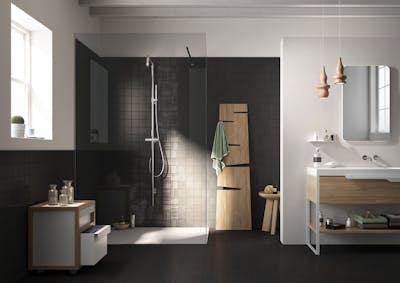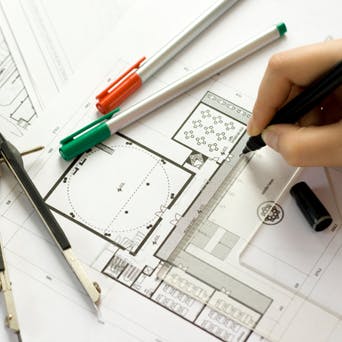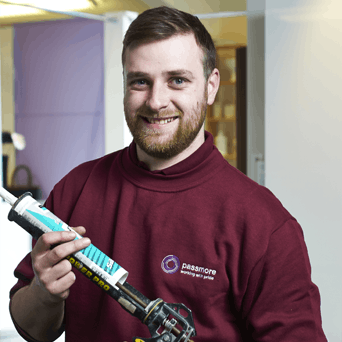Bathroom Renovation Guide: Order of Work
Published: 25 November 2019 · Last Updated: 3 October 2024
Renovating a bathroom can often seem daunting. But when you take a good look at all the different elements that go into a renovation, the process looks a lot more manageable.
We know it’s a big task, so we’ve broken down bathroom renovations into five key steps to consider before taking on the transformation.
Taking a step-by-step look at a suggested bathroom renovation order of work, we’ll also answer some of the most common questions we hear, like how much a bathroom renovation should cost and how long it will take.
The five key steps to consider
Whether you choose to renovate your bathroom yourself or call in the experts, there are five key steps you need to consider:
- Assessing your requirements
- Setting a budget
- Choosing the perfect design
- Removing your old bathroom
- Installing your new bathroom
Step 1: Assessing your bathroom requirements
Take a good long look at your bathroom, evaluate how you use it and what you’d like to improve.
If you don’t use the bath often, or if you don’t have children using the bathroom, it may be better suited for you to transform your bathing area into a walk-in shower.
Although it’s not all about functionality - if you have a large bathroom with unused space, you may want to add a free-standing bath to create a fantastic statement piece.
There are hundreds of great adaptations you can make to your bathroom. To avoid getting lost in bathroom renovation ideas, note down your bathroom essentials - what you definitely can’t do without. This will also help you to set a practical budget.
Step 2: Setting a budget
Once you’ve decided on your bathroom necessities, it is time to decide how much you wish to spend on your bathroom upgrade. You’ll need to consider the following costs:
- Sanitary ware and fitted furniture
- Wall and floor coverings
- Lighting and ventilation
- Labour rates (fitters, plumbers, electricians and decorators)
Be realistic: the cost of fixtures and fittings can vary widely depending on the quality and type of goods you choose.
The labour costs will also vary depending on your bathroom size and the plumbing and electrical work you require.
Set a budget with a little flexibility until you’ve chosen your bathroom renovation design and fittings.
Step 3: Choosing your design
The next step in the bathroom renovation order of work is selecting your bathroom design through your choice of finishing touches that cover:
- Colour scheme
- Sanitary ware
- Wall and floor coverings
- Lighting
- Fitted furniture
- Heating and ventilation
Colour scheme
Your choice of colour scheme helps to set the mood and tone of your bathroom. Brighter colours such as yellows, oranges and greens can help to boost your mood, whilst lighter colours such as white and beige help to turn your bathroom into a relaxing sanctuary.
Sanitary ware
There are of course plenty of options when it comes to sanitaryware too, and as a bathroom renovation can be a relatively large investment, it’s always best to view the sanitaryware first. Whether you’re completing a bathroom renovation alone or getting help, we recommend visiting a bathroom showroom before you make any sanitaryware purchases.
This allows you to view WCs, showers, baths and basins directly, ensuring the size, colour and quality match your requirements.
Wall & floor coverings
There’s a wide variety of wall and flooring covering options available with a large difference in price points, but the most popular choices include tiles, wall boards and vinyl flooring.
Here, you can make bathroom design choices according to your budget. For example, if you require high-shine wall coverings to bounce light around your bathroom, you can choose between glass tiles or acrylic wall boards, both varying widely in cost per unit.
Lighting
Review how much natural light your bathroom windows are currently providing, then decide the type of lighting you require. Options include:
Task lights - used to illuminate areas that are needed to perform a specific task.
Ceiling lights - used to create general illumination
Downlights - provide a good level of ambient lighting and can be used to enhance statement features within a bathroom.
Fitted furniture
Consider fitted furniture if you have limited space or want to hide away your bathroom amenities. Savvy storage solutions include wall cabinets, built-in vanity units, bathroom wall niches and recessed fitted furniture.
Heating & ventilation
There are several heating options in bathrooms, but the main heating solutions are heated towel rails and underfloor heating.
Heated towel rails are a sleek addition to any bathroom design, whilst underfloor heating is a great option for bathrooms with tile flooring, particularly wet rooms.
Ventilation isn’t a necessity when renovating a bathroom, although it is now a legal requirement in newly built homes. Ventilation can be provided via standard fans, which need to be manually turned on and off, or humidistat fans, which work off the amount of humidity in the bathroom.
If you decide to go with an expert bathroom fitter, you’ll benefit from professional design advice. You’ll be able to discuss your bathroom requirements and create a design that is best suited for you, your space and your budget.
Step 4: Removal of your old bathroom
If you’re not doing everything by yourself, your chosen fitter will arrive on-site to begin the process of removing your old bathroom suite, wall and floor coverings. A skip will usually be provided on-site to get rid of any unnecessary items.
A protective film needs to be laid from the doorway to the bathroom to avoid any flooring getting dirty or damaged.
Step 5: Bathroom installation
The final step in the bathroom renovation order of work process is the actual installation. The usual bathroom installation stages are:
1. First fix
The first fix consists of any plumbing and electrical requirements.
2. Wall coverings
Walls are covered with your choice of tile or wall boards.
3. Floor coverings
Floors are covered with your choice of tile or vinyl flooring.
4. Sanitary ware and furniture installation
Your choice of sanitary ware and fitted furniture are installed.
5. Finishing touches
Finishing touches including mirrors and bathroom accessories are included at this stage.
How long should a bathroom renovation take?
For a standard sized bathroom, on average a renovation will take two weeks (80 hours).
Of course, this can vary depending on your specific requirements, and additional labour time can be added depending on the task. For example, if you choose to move your toilet, extra time will be added to change the location of your waste pipe.
How much does a bathroom renovation cost?
On average, improving an existing suite will cost between £3 - 6K.
A complete refurbishment, with new fixtures, fittings, tiling, etc, costs between £6 - 8K.
Significant redesign, involving complete refurbishment including layout change some minor building work costs £8K+.
Ultimately, the average bathroom renovation cost will vary depending on your choice of wall and floor coverings, sanitaryware, fitted furniture and labour costs.
If you wish to get more information on how to renovate a bathroom and further discuss your bathroom renovation requirements, book your free no obligation design appointment with one of our senior designers today!
Share this Post




.jpg?auto=compress%2Cformat&cs=strip&fit=clip&h=400&ixlib=php-1.1.0&w=400&s=5eeedabe07060d4a519a0b98e2cb700e)

















